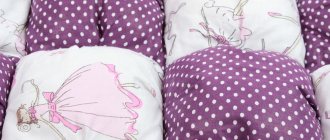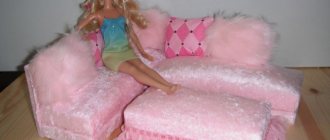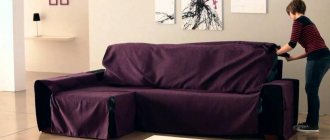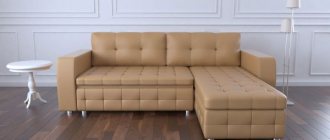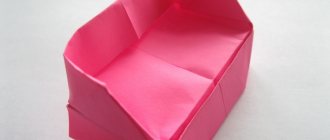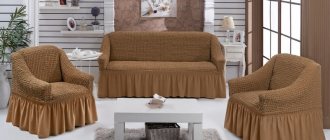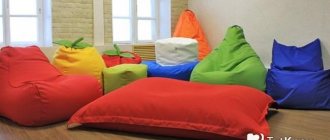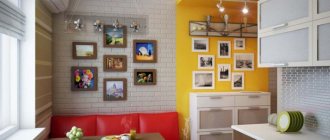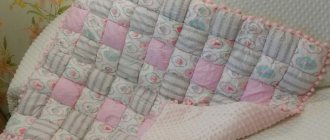If there are small children or pets in the house, then the owner of the living room - the sofa will require additional protection. The best way to ensure this is to purchase a bedspread or cover for the sofa. If you have experience in sewing or a great desire to try to make something with your own hands, then why not sew a case yourself? Such a product will be able to add a unique decoration to the interior of the living room, and will also provide the room with an atmosphere of home comfort. In this article we will tell you how to sew a bedspread on a corner sofa with your own hands.
How to sew a sofa cover with your own hands: step-by-step instructions
Nothing lasts under the sun. This is also true for upholstered furniture, which is daily subjected to “torture” by the claws of pets, which is a canvas for little artists, and which has a hard time enduring “incursions” from guests. Even new sofas and armchairs quickly lose their attractiveness, which greatly depresses the owners. The only salvation in such a situation is a removable cover. This product can be bought or ordered, but the prices are daunting. Therefore, self-production is fully justified. But before you sew a sofa cover with your own hands, step-by-step instructions are the first thing you need to carefully study. Strict adherence to it is a guarantee of results.
Choosing the right fabric
The “longevity” of a sewn sofa cover directly depends on the material, so it is not recommended to choose it in a hurry. The main requirements are strength, density, wear resistance, if there are four-legged “tenants” in the house, and the ability to withstand claws. It’s good if the material is impregnated with a water-repellent composition, in which case washing will be completely easy. There is no ideal fabric yet; they all have their own strengths, but they are not without their disadvantages.
- Velours. This velvety material does not require maintenance, is relatively inexpensive (compared to velvet), and is wear-resistant. Any dirt can be easily washed off. The downside is the fear of claws, so velor is not recommended if mustachioed tabbys are in charge of the house.
- Jacquard is dense, durable, but quite light. Thanks to twisted threads, the fabric is resistant to abrasion and deformation. The material has a pleasant texture and impressive appearance, but there are disadvantages: cats love it, the natural variety is expensive.
- Microfiber (microfiber) is a universal fabric, as it does not fade, does not wear out, and dries instantly after cleaning with water. It is waterproof, hypoallergenic, and pleasant to the touch. There are types with Teflon coating that are completely invulnerable.
- Flock is a durable and pleasant material that retains its shape even after long-term use. All the advantages of microfiber have the Teflon variety of flock, which is very easy to wash and dries incredibly quickly. Animal claws are no problem for her.
- Cotton is attractive for its naturalness, but at the same time it is a disadvantage. Such a cover will not last long; the fabric shrinks after washing and easily fades. However, cotton remains a desirable material for children's rooms.
- Chenille is a beautiful velvety fabric, light, soft, but dense. But there are many disadvantages - a contraindication for “cat houses”, fear of moisture, aggressive agents, direct rays of the sun.
- Eco-leather is an ideal solution if there are no people in the house who like to scratch and bite upholstered furniture. These covers look good in living rooms. Children are also not afraid of eco-leather, since any “art” can be wiped off very easily. However, this is not true for all species.
Textiles for a “case debut” should not be expensive, since mistakes are common for a beginning craftswoman. Uniformity is also welcome, because in this case, on the way to the goal, there will be no torment with adjusting the pattern. The best option for an inexperienced cover-maker is to practice on inexpensive fabric, or even better - on old sheets. In this case, mistakes will not be too costly. The first case that does not turn out “lumpy” will give the craftswoman a pattern for the next, already expensive, product.
Cover fabric and interior
When choosing fabric, we must not forget about harmony. If the walls of the room are decorated with colorful wallpaper, then the best option would be a plain material - matte or glossy. Monochrome surfaces, on the contrary, even allow bright fabrics, but there is one requirement - the pattern on them must be small.
Making a cape cover
The simplest option to achieve what you want is to make a continuous “bedspread” for the sofa. The parts are cut out and then put together into a single whole. For the “sofa cover” operation you need to prepare:
- textile;
- centimeter;
- ruler;
- chalk;
- tailor's scissors;
- tracing paper, graph paper, newspapers or unnecessary wallpaper;
- pins or needles;
- threads: ordinary for basting, lavsan - for a sewing machine.
Material calculation, pattern
Task #1 is determining the amount of fabric. Before you go to the store to buy it, you need to carry out this operation. If the sofa has standard dimensions, then the cover will require approximately 8 m of fabric. For a more accurate calculation, measure the length and width of the furniture, multiply each figure by 2 and add it up.
Further calculation assumes a standard fabric width of 1.5 meters. If the sofa has a length of 210 cm and a width of 180 cm, then 7.8 m of material will be required. However, this is only an approximate guideline that requires final adjustment, so before going to the store you need to make a full-fledged pattern.
For it, the dimensions are written down on paper and the shapes of all areas and the smallest details are drawn on a small scale. Then they are transferred to life-size paper (or newspapers or wallpaper glued together). Leave allowances for seams, hems, 7 cm - the required minimum for covers. After receiving large parts, they are applied to the sofa and all dimensions are checked.
Fabric consumption will increase significantly if the choice falls on a material with a pattern that requires matching at the seams. In any case, it is recommended to add another one to one and a half meters to the resulting figure. In this case, it is easier not to get into trouble, and the remaining material will be useful for replacing worn-out areas of the cover, adding frills, ruffles, and pillowcases to decorative pillows. If there is still not enough fabric, then it is “stolen” from the back of the back, for which another fabric can be used.
The process of cutting fabric, sewing
When all the elements of the pattern fit perfectly, begin cutting the pre-prepared fabric. Woolen and cotton material is washed in warm water in advance so that it shrinks, otherwise the cover may simply not fit on the sofa after washing. Ironing through damp gauze is mandatory for any fabric.
It is placed face down on a flat, hard surface. Taking into account the direction of the grain thread, the patterns are laid out on the fabric and secured with needles or pins. They are drawn along the contour with chalk, and a second line is drawn at a distance of 7 cm from the first line. The material is cut out from it.
The resulting parts are folded with the wrong side out, a basting is made, then fitting on furniture follows. If there are no defects, the allowances are reduced to 3 cm, the seams are ground down, the edges are folded, basted, and after a new fitting they are stitched.
Covers for corner sofa
For sewing, covers for corner furniture work in a similar way, in which the most important thing is a correctly made pattern. There is only one difference: first, two parts are sewn separately, then they are joined together. Each seam from the inside is treated with non-woven tape; this additional work will help the sofa cover of a complex shape to hold it. The fabric is secured at the corner joints, otherwise the product will look like a carelessly thrown cape.
A witty way
This is the simplest option and allows you to get the case very quickly. For it, they take a fairly large piece of elastic fabric, with which the sofa is completely covered. The hanging parts are trimmed from below or the furniture is turned over and the excess is pulled off at the bottom. Excess fabric on the armrests is eliminated with draperies. To avoid displacement of the cover, wooden slats or pieces of metal-plastic pipe are inserted between the seat and other parts.
Red plaid 3 D
Crochet blanket from 3 d squares. Crochet granny square 3 d effect. You will need a 4 hook for a blanket measuring 2 by 2.20 m, 8 by 9 squares. Pekhorka merino yarn. I combined the motifs during the knitting process. I immediately hid the knots.
A few useful things
Some tips will help minimize the risk of annoying interference and errors, which can sometimes ruin all your efforts.
- When transferring patterns to fabric, under no circumstances should you skimp on allowances. Excess material is easy to remove, but not enough will be catastrophic.
- When working with dense fabric, you cannot use a small stitch width. The optimal step is 1.5-2 mm and two seams. Otherwise, the fabric is easy to damage.
- A loose cover is a lesser evil, since the excess quite easily becomes less noticeable if you tighten it with elastic bands stitched into the seams.
- If a cover is required to protect a leather sofa, then even a cover made of durable fabric requires additional foam padding to prevent the material from slipping and claws.
- The “hem” of the cover is too wide - a defect that can be eliminated with a drawstring through which a simple linen elastic is threaded.
- Those who master knitting needles can knit individual parts, and then just carefully sew them together.
- A tight product is worse than a loose one, since constant tension does not contribute to durability.
Functional Features
When making a textile item, you need to immediately determine what and why it is needed. The thing performs several functions at once, which are of great importance in their field:
- The sofa upholstery is protected from mechanical and other damage.
- Does not allow dirt to penetrate into factory upholstery.
- Decorative. A handmade product will be unique and add an atmosphere of comfort and individuality.
- An additional feature of the model may be the presence of a blanket.
Functionality
You can come up with a few more elements that will make the thing more original. You can sew small pockets to the sides of the cover. Here you can store the TV remote control, magazine, glasses.
Features of the cover for the corner sofa
When thinking about the interior of your home, you want everything in it to be perfect. But even expensive, good furniture gradually loses its presentation or becomes mechanically damaged. This is especially true for a sofa where children or pets rest.
You need to think about its safety in advance.
Advantages of using a cover for a corner sofa:
- Protection of upholstery from fading and wear;
- Easy to wash the cover when dirty;
- Possibility to refresh furniture at any time;
- Wide range of materials, including hypoallergenic;
- Saving money.
If everything is clear with a cover for a standard sofa, then a blanket for a corner sofa raises many questions.
Usually they are ordered or made independently. There are one-piece and composite covers. Sometimes only some part of the furniture is covered with fabric, and not the entire area.
The back is closed only if the sofa is not close to the wall.
A special feature of covers for a corner sofa is the need to secure it using special elastic bands, buttons or metal fittings. Otherwise, parts of the cover will constantly slide off.
Why is it better to sew a bedspread yourself?
It is best to sew a thing with such functionality yourself. There are several good reasons for this:
- You can choose individual dimensions and shapes.
- Any material can be used.
- Any type of material can be used as finishing.
- The color of the item depends on personal preference.
- It is easy to choose an individual product design.
Design
In addition, the item will be of high quality and will definitely last for many years.
Decoration methods
You can make a decorative stitch in the center or in selected places along the front. It can be straight, zigzag or wavy - it all depends on the type of machine.
Other options for decorating a bedspread:
Small ruffles are located along the edge, on the surface; to decorate the edge of such frills you need an overlocker with threads in the color of the material.
Ribbons, lace, flounces, puffs, braid are made on plain fabric, sometimes they select an option for colored ones.
Applications from ready-made drawings on the material or made as independent paintings.
For tapestries , gilded threads and silver trim .
Buttons and other hard parts are not recommended, as they will cause discomfort when resting.
Necessary equipment
The set of tools depends on the design of the product and the type of fabric. The standard set of sewing accessories will be the following tools:
- Scissors or textile knife.
- Chalk, measuring tape.
- Awl, thread, needle, safety pins.
- An elastic band, tape or lace to secure some parts.
- Sewing machine for forming basic seams.
- Iron for smoothing seams.
Depending on the model and special manufacturing conditions, other tools and devices may be used.
Required Tools
The main tools of labor, naturally, are a hook or knitting needles. They are available for sale in a variety of materials:
- metal;
- plastic;
- bone;
- wooden.
Large selection of knitting needles for knitting a wide variety of products
“Correct” knitting needles have their own characteristics: they must be well polished and not have too pointed ends so as not to injure your hands. At the same time, it will also not be possible to knit a high-quality product with blunt instruments, as well as with uneven ones.
If the knitted blanket is made from light yarn, you can use plastic or bone knitting needles: heavy material will bend them.
They differ in material, numbers and shape: for different products they have their own. The numbers correspond to the diameter of the knitting needle: No3 - 3mm, No6 - 6mm and are directly related to the thickness of the yarn - they should exceed it by 2 times.
In addition to knitting needles, other tools may be needed.
| Name | Why are they used? |
| Knitting pins | To “stop” loops |
| Row counter | Fixes the row number |
| Knitting thimble | Makes knitting jacquard patterns easier |
| Bobbins for yarn | For working with colored materials |
| Marking rings | Fix the beginning of a circular row or a specific place in the pattern |
| Colored tips | Prevents loops from slipping |
| Scissors with pointed ends | For additional work |
An iron, notebook and drawing supplies may be useful for creating patterns and drawings.
A variety of tools and accessories to make the knitting process easier and more enjoyable
Material selection
There are many tactile design options that are suitable for sewing this item. During the selection process, you should pay attention to some nuances that will help you decide. It is necessary to take into account how long the item is intended to be used and what appearance it will have after sewing.
- Cotton fabrics have many advantages. Pleasant to the touch, do not cause allergies, durable, beautiful, lots of colors. Disadvantage: they shrink after washing.
- Woolen fabric is quite durable and warm, and looks very attractive. May prick, cause allergies, not suitable for summer use, expensive.
- Natural silk is expensive, it is difficult to wash or clean it from dirt, but the textiles look expensive and rich.
- Synthetic fabrics are used most often, they have many advantages that are inherent in natural fabrics, and at the same time they are inexpensive. Disadvantage - they can accumulate static electricity, making it difficult to choose a high-quality option.
- Tapestry is the most relevant and suitable textile option for sewing furniture covers. It holds its shape well, is dense, does not shrink during washing, and has an expensive and attractive appearance.
When choosing any type of textile, you should pay attention to quality. If the fabric is woven from thin fibers that do not lie neatly, then even the most expensive product will quickly become unusable at the time of use.
Suitable materials
Note! Instead of fabric, strips of bamboo are often used to form covers for a sofa, armchair or chair.
In addition to aesthetic characteristics and quality, you need to pay attention to additional functional features - hygiene, hypoallergenicity, tactile perception.
Color selection
It is worth following the recommendations in terms of choosing the color of textiles:
- In a small living room, the color of the cover should match the tone of the curtains or carpet.
- In huge rooms, bright and colorful products can be used. Dark colors in a large room will make it visually smaller and cozier.
- For northern rooms, shades of warm colors are welcome. A space constantly flooded with sunlight is perfectly shaped by cool colors.
- Lovers of change can afford a double-sided bedspread.
Important! If you need to hide the wear and tear of a sofa, it is better to make the product lush and with many small details.
Design and shape
To make a cut, you need to decide on the model and shape. There are several basic options. The shape of the parts can be angular or rounded. As for the model, it is important to take into account the type of sofa itself - corner, round, long, square.
Shape and design
There may be fasteners in the form of ties, elastic bands, buttons, or zippers. Additionally, you can sew on ruffles, frills, inserts and frills.
Fabric consumption calculation
To sew a blanket on a corner sofa with your own hands or on a straight one, you need to correctly calculate the fabric consumption. To do this you need to do the following:
- Take measurements from furniture.
- Decide on the model and design.
- Take into account fabric shrinkage.
Additional information! To check the degree of shrinkage of the fabric, you need to wash, dry and iron a piece of fabric. Then compare the resulting piece size with the original one.
Additionally, you need to take into account the consumption of several cm for hems and edge processing.
I have yarn, what to do next?
And then you need to calculate how many knitting loops are needed. You can do this yourself by calculating how much yarn goes into a square, for example 10*10 centimeters, and, based on this, calculate how much is needed for a large blanket.
You can also make calculations using special online calculators, but be sure to take into account the pattern you will be knitting with.
You should practice knitting the chosen pattern in advance, on a small number of stitches, and start a large amount of work only when the trial version turned out well and you are completely satisfied.
Sewing a cape yourself
To understand how to sew a blanket for a sofa with your own hands, it is worth considering a technique such as patchwork. The technique involves several levels of complexity, which allows even a beginner to cope with the work.
Patchwork bedspread
A great idea for home use is a patchwork blanket. During the creation process, many colored pieces of fabric are sewn together to create a unique design.
Patchwork for bedspread
There are a ton of patterns that can be used when creating a unique design.
Patchwork and denim
Not so new is denim patchwork, which is easy to implement. In this case, you don’t need to look for material - just cut a lot of identical shreds from old jeans. To diversify the “pattern”, it is worth using scraps from a different fabric.
Denim patchwork
The instructions for working on such a masterpiece consist of just a few successive steps - preparing identical scraps, forming a pattern and sewing together the parts.
Patchwork with a cookie
When creating a patchwork style cape with a fig, you should use the following “pattern”:
Creating a patchwork
In the process of working on such a product, you need to know the principle of creating the cookie itself.
Tapestry knitted capes
If you want to get a beautiful, dense and multi-functional blanket-cape for the sofa, then you should try to make a model that consists of tapestry scraps that are tied together with yarn.
Knitted tapestry
You can form the connecting part for tapestry scraps using knitting needles or a crochet hook. It is enough to knit long strips with any pattern, to which scraps of fabric will subsequently be sewn.
Capes without armrests
A cape without armrests is the simplest to make. It is worth using this pattern for work:
Without armrests
The manufacturing master class is completely clear from the sewing instructions.
Bedspread for a corner sofa
To decide how to sew a cover for a corner sofa, you should first take measurements of the furniture, and then start working on the item.
Corner cape
Very simple beautiful blanket
This plaid looks very beautiful, and is knitted almost exclusively with knit stitches.
How to knit
- The first 8 rows are a garter stitch border (in all rows: both knit and purl - knit).
- Next, we distribute the loops according to the patterns: at the beginning and end of each row there are 8 border loops.
Main pattern:
- all odd rows are knit stitches.
- Rows 2, 4, 6 – slip three stitches without knitting, knit three.
- Rows 8, 10, 12 – all knit.
Master class on sewing and knitting a stylish sofa cover
A sofa cover is a universal accessory that can perform many important functions. Protection from small children and pets, masking stains or out-of-fashion design of upholstered furniture, refreshing the interior - all this becomes possible if you purchase a beautiful modern European cover or a stylish cape to match home textiles and wallpaper.
Product for newborns
Knitted blankets and blankets for newborns should be made from hypoallergenic and high-quality materials. It is optimal to use yarn with a combination of acrylic and wool or merino threads. The yarn should have a soft texture, the threads should be elastic and durable.
It is recommended to purchase specialized formulations for young children.
The product of medium density is standardly made with dimensions of 89x96.5 cm. For production you need 4 skeins of yarn (100 acrylic), knitting needles for circular knitting 5.0 mm. After face knitting, the blanket is decorated according to the diagrams with descriptions. On the front side you need to add 6 loops and tie the product in a circle. The work is completed by closing the loops and fixing the threads in the product.
Types of furniture covers
However, buying a ready-made cover is not so easy, even if the furniture owners are not limited by budget. And all because it is extremely difficult to choose an accessory that is ideal for a specific model. An exception is ordinary capes, but they are less practical and convenient to use, since a rectangular piece of fabric will not be able to cover the entire sofa and will constantly slide off its surface.
Fabric covers
There is another option to get the coveted case, which consists of individual tailoring to order. However, it also has one significant drawback, which is the considerable costs of materials and their processing. In addition, it is far from a fact that the studio will do their job quickly and efficiently, because sewing a continuous cape requires constant adjustment, which is almost impossible to ensure if there is no furniture nearby.
That is why it is much easier to sew a Euro-cover for a sofa with your own hands, constantly taking measurements from it and applying the cut parts to the furniture, which is very convenient and useful for a successful result. Don’t be afraid of the complexity of this process, because there are several easy ways to sew a sofa cover that even a novice craftswoman can do.
Before you start cutting and sewing, you should think about what exactly your dream bedspread should turn out to be, because the harmony of the entire interior depends on this detail. Currently, the most popular models are:
- One-piece case without fasteners. As a rule, such models completely replicate the furniture silhouette with a small margin, so they are quite easy to take off and put on. At the same time, they “sit” firmly on the furniture, without sliding off it after someone sits down or stands up, which is very convenient. As for the design, such cases can have not only a strict geometric silhouette, but also a flirty frill around the entire perimeter. Usually the first option is made from dense simple fabrics such as coarse linen or cotton, opting for plain fabrics in light pastel colors. But for the second model, it is better to choose a colorful fabric with a floral print, which is ideal for interiors designed in the style of shabby chic and Provence. In addition, you can sew stronger and more durable, but no less elegant, covers from thick tapestry fabric, which is a good old classic that goes well with natural wood, baroque ornate patterns and crystal chandeliers. If you need to make a child’s pattern for a chair cover with your own hands, then you should take a closer look at the easy and simple patchwork technique made from colorful scraps taken from different fabric cuts.
- If you don’t want to bother with frills and straight floor-length silhouettes that are quickly trampled by guests, then you can make your own sofa cover with an elastic band that ensures a rigid fixation of its edge under the seat. The principle of sewing the upper part of such an accessory is no different from the model described, while its bottom is made shorter with folds in the corners or along the entire perimeter, necessary to thread a wide elastic band. If desired, you can replace the elastic with fabric or twisted ribbons, using the hem as a drawstring.
- There is another option for sewing a sofa cover, the peculiarity of which is the use of special rubberized fabrics over the entire area. This material is quite dense, but at the same time it stretches very well, completely hugging the surface of upholstered furniture. The only drawback of rubber covers is that they require additional fixation in the area of furniture seams, which is not always possible to provide. There are two ways to solve the problem, the first of which involves making each element separately (seat, back, armrests) without further joining them into a common fabric, while the second involves abandoning the sewing of rubber bedspreads in favor of models made from ordinary non-stretch fabrics with a rubberized edge or a frill at the bottom.
The most popular fabrics for permanent or removable furniture upholstery are velvet (velor), natural suede, tapestry, plain and Teflon flock, cotton (cotton), microfiber, jacquard and chenille.
When using a combination of different fabrics for sewing patchwork bedspreads, it is recommended to choose those materials that will have approximately the same density and thickness, otherwise the finished product will very quickly become unusable, stretching or even losing its integrity in certain places.
Knitted blankets
Perhaps the most stylish removable covering for upholstered furniture today are handmade knitted bedspreads. Such blankets turn out to be very delicate, fitting perfectly into the interior of bedrooms and children's rooms, and it is on a knitted cover that it is most comfortable to drink coffee with milk, play with a child, read colorful books or just hug.
The most commonly used models are the following, which you can easily make yourself:
- Fine knit jacquard blankets. These bedspreads are suitable for cribs and chairs, as they are made from thin yarn. Most often, capes are made in light pastel colors, making them monochromatic, although it is quite acceptable to combine two or more contrasting shades. Checkerboard blankets look very cool, divided into separate sectors, each of which is knitted using different techniques (one square with stockinette stitch, the second with garter stitch, the third with aran stitch, etc.) or filled with delicate monochromatic or colored jacquard patterns (bunnies, snowflakes, hearts , starfish, etc.).
- For stylish loft, minimalism and hi-tech interiors, voluminous capes are made from the thickest cotton yarn. This pleasure is not the cheapest, so it is better to buy threads and knit such a blanket yourself, especially since due to the thickness of the material, the work time is reduced to several days. Most often, for knitting bedspreads from the thickest yarn, stockinette or garter stitch is used. The finished product looks both catchy and gentle, suitable for both a woman’s bedroom, decorated in light colors, and a brutal bachelor’s apartment. In this case, you need to knit from thick yarn either with giant wooden knitting needles or by hand, using the same technique as for crochet, only pulling out each new loop by hand.
The undoubted advantage of knitted blankets compared to sewn ones is that they are much easier to adjust to furniture, and this is especially true when it comes to models such as click-clack (a sofa that transforms into a bed and vice versa) or solsta with its rectilinear geometric forms. In addition, the product can always be remade by undoing the row in which the mistake was made. As for the disadvantages, the main one is the washing properties of the blanket, because knitted items tend to shrink, stretch and dry for a long time, often “suffocating” after hand washing and a weak spin.
We sew a sofa cover easily and simply!
Sewing a replacement sofa cover is a great alternative to replacing old upholstery. In addition, the covers are removable, which means they can be washed. Sew several covers and change them from season to season or depending on the occasion. Your furniture will be reliably protected from dust and grime. It will retain the natural color of the upholstery for a long time and will not be damaged by the claws of pets.
Look at the options for sofa covers that we suggest you make with your own hands.
When choosing fabrics for a cover, you can come up with unexpected combinations and different types of finishes.
Follow our instructions and you can easily change the style and mood of your living room.
The cover consists of three elements: a lining, a cross-shaped top and decorative elements on the corners of the sofa. The top of the cover in the photo below is made of tapestry fabric, which contrasts with the iridescent silk of the corner elements.
Making a cover pattern
Start with four basic measurements: cover length, width, armrest length, and armrest width.
Taking measurements
For the top of the case:
1. To determine the length of the cover, measure the sofa from front to back, starting from the floor in front of the sofa and ending with the floor behind the back, plus 25-30 cm for a loose fit, plus allowances for hems. 2. To determine the width of the cover, measure the sofa seat plus seam allowances. 3. The length of ONE armrest is measured from the seat through the armrest to the floor plus 25-30 cm for a loose fit, plus allowances for hems. 4. To determine the width of the armrest, measure the width of the sofa seat plus seam allowances.
For lining:
Length = length of the cover according to point 1 above. Width = the width of the cover (point 2 above) plus two lengths of the armrest (point 3 multiplied by 2), and minus 2 allowances for hems.
Sewing Tips:
Lay out the parts of the cover on the sofa with the wrong side up, determine where to sew the side parts (armrests) and baste them to the central part.
Lining
Case design option
Elegant case with brocade top
To prevent the fabric of the cover from “wrinkling” when you sit on it, prepare wooden rods equal to 5/8 of the length/width of the sofa and recess them between the seat and backrests. If the sides of the sofa are curved, use a PVC water pipe of the appropriate length for the same purpose, bending it into the desired shape.
Our option for sewing a cover for a sofa, consisting of a lining and a top, allows you to choose the fabric for decorating the sofa that you like, but it is not enough to sew a whole cover. For example, pieces of antique fabrics.
Decoration of corners
The corners of the case can be designed in different ways, with careful selection of accessories, and get impressive results. Use our ideas to start imagining!
Part of the cover from the armrest is tied into a large knot
The case is laced with small brass grommets
Lace-up buttons
Fastening with decorative buttons, snaps or zippers
Instead of a cord, you can use belts with rings, which are sewn from the main fabric of the top of the case
Let your home always make you happy, give you warmth and comfort. Success in creative work! If you liked the ideas! Share them with your friends!
Source: cpykami.ru
What fabric to choose for sewing a sofa bedspread?
Where to start sewing a blanket? First of all, you should decide on the fabric from which the bedspread will be made. When choosing a material, you need to pay attention to its performance characteristics: wear resistance, moisture resistance, density, tactile qualities and appearance. What parameters should you use to choose fabric for a bedspread on a sofa?
Functions of the bedspread
The bedspread performs not only an aesthetic function, although appearance plays an important role when choosing material. A furniture cover or blanket is needed to:
- protect furniture upholstery from dirt and damage;
- warm in the cool season;
- cover defects, such as worn upholstery.
If the bedspread will perform only an aesthetic function, then you can choose a light flowing satin as a material, which will fit perfectly into a classical-style interior. If the sofa cover will also be used as a blanket, then it is better to opt for dense and warm fabrics - wool, microfiber, faux fur.
Frequency of use of a piece of furniture
Materials such as tapestry and jacquard have proven themselves best in terms of wear resistance. They are dense, strong, and do not wear out over a long service life. Curtain fabric also works well. Curtains and covers made from the same fabric will look great in the living room.
Color plays an important role when choosing fabric. Products in light colors look good in small rooms, living rooms, and children's rooms. However, it is worth considering that such covers will have to be washed frequently. If the blanket is used often, it is better to choose dark, non-staining colors: brown, burgundy.
Presence of small children and animals in the house
If there are children in the house, the fabric for the cover should be durable, waterproof and hypoallergenic. Jacquard, wool and fur are not suitable for a children's room because they accumulate a lot of dust, which can cause allergies in a small child. The best choice is microfiber or acrylic. These synthetic fabrics are hypoallergenic and easy to wash in a washing machine, which is especially important in a home with small children.
Pet owners know that sometimes their pets like to sharpen their claws on a furniture cover or chew on it. That is why you should buy a flock or microfiber blanket for a house with a cat or dog, which does not leave claw marks.
Quilted bedspreads
The sophisticated color scheme will lift your spirits and please the eye. The advantages include the fact that they have a sealant inserted between the main material and the lining fabric, most often a padding polyester.
Thanks to this combination of fabrics, the bedspreads are lush and soft, hiding the folds on the sofa. There are these types of stitches:
- thread stitching - expensive models;
- thermal stitch.
Thermal stitching is used only for bedspreads made of artificial fabrics. It involves bonding the layers of a bedspread using a special device that precisely melts synthetic fibers.
In unison with the rug
It is voluminous and takes up a lot of storage space. Therefore, it is difficult to wash. Any bedspread must be washed at least 2 times a year. Or clean it from dust and be sure to ventilate it.
Selection of models by style
The easiest way is to choose a simple monochromatic quilted bedspread; the only difficulty will be the selection of harmonious shades.
Bedspreads with patterns require special attention. The difficulty lies in choosing styles. For example, the Borocco and Rococo style is characterized by bedspreads made of satin and silk fabrics, decorated with frills, ruffles and lace.
Bedspreads decorated with small monotonous flowers are typical of Provence. Monochromatic colors, straight lines or checkered patterns are preferable to Classicism. The patchwork technique, as a rule, harmoniously combines with the country style: highlighted squares with delicate roses and a diluted picture with bed tones will create charm and comfort.
Cozy option for reading a book
3D flower designs will fit perfectly in the Art Nouveau style, with delicate frills and an animal skin rug. Modern motifs with metallic shades, of course, are assigned to High-Tech, but it is possible that it will not suit Loft; for this you need to add several symmetrical lines.
An oversized bedspread on your upholstered furniture will look untidy, dirty and give the effect of disorder; the bedspread should correspond to 110 by 140 cm. For a double bed, the following standards have been noted: 200 by 220 cm.
European beds are famous for their maximum sizes, so a bedspread for a standard double bed will be small, so choose sizes from 220 by 250 cm to 230 by 250 cm.
In the style of minimalism
How to sew a sofa bedspread with your own hands?
You can buy a bedspread for a bed, sofa or ottoman in a store, or you can sew it yourself. The latter option has many advantages. Firstly, the needlewoman will be able to implement exactly the option that she came up with herself. Secondly, such a cover is suitable for furniture of non-standard shapes and sizes. Another argument in favor of a homemade blanket is the originality of shapes, colors and execution techniques. How to sew a blanket for a sofa with your own hands?
Sofa model (book, corner, etc.)
Thick fabrics (tapestry or jacquard) are too stiff for corner furniture. They bulge in the corners and do not take the shape of the sofa. It is best to use flowing, draping materials for sewing - thin wool, satin, acrylic fabric.
Measuring a sofa and creating a pattern
Sewing any product begins with taking measurements and creating a pattern. Standard models have the following average back dimensions (meaning width):
- double sofa – 120–160 cm;
- three-seater – 160–245 cm;
- corner – up to 550 cm.
The main parameters that need to be measured, in addition to the width of the sofa, are the width of the seat, the height of the backrest and the height of the armrests. When constructing a pattern, it should be taken into account that the bedspread should lie freely on the surface. You should not do it end to end; it is better to leave 20–30 cm of fabric that will hang down the sides and back of the sofa.
For complex models of corner sofas, it is recommended to sew not a single bedspread, but several separate covers for each element of furniture. Such covers are cut out separately.
Cutting and sewing
To cut fabric you will need the following materials:
- chalk, a piece of soap or a simple pencil for transferring lines onto light fabric;
- scissors;
- ruler;
- safety pins or thread with a needle for fixing the pattern on the fabric.
After cutting, all elements are sewn together using a sewing machine. They can also be connected manually, but this is a more labor-intensive process that requires high skill from the needlewoman. The bedspread can be made using the patchwork technique. There are many patchwork techniques, but the general idea is that small pieces of fabric are sewn together to form one blanket. The flaps can be of different colors and even from different materials.
Methods for fixing a product on a piece of furniture
How to fix a cover on furniture so that it does not slip? There are various mounting methods for this. One of the most convenient options that is optimal for a book sofa is elastic bands around the edges. The elastic can be sewn around the entire perimeter of the product or only in the corners. This cover is convenient to put on, it does not slip and holds tightly.
Most often, not a whole bedspread is sewn onto a furniture corner, but several separate covers. They can be connected to each other with buttons, buttons or Velcro. Buttons and snaps are not very easy to use, they can interfere with those sitting on the sofa, so it is best to sew velcro tapes to the covers.
How to knit a blanket beautifully
The first few rows and the same number of the last ones also need to be knitted in a pattern for the border.
For knitting a border, any dense pattern is suitable: garter stitch, pearl stitch, etc., or even two different ones at the same time, as in the example in the photo above.
Isn't it very beautiful?
In the second case, it is more convenient to crochet the finished blanket around the perimeter with single crochets: two to three rows.
If desired, you can decorate the edges of the blanket not only with tassels, but also with pom-poms.
Rules for caring for a bedspread or blanket
Recommendations for caring for blankets vary significantly depending on what material the product is made of. Before sewing a cover, you should familiarize yourself with the washing rules of the selected fabric and make sure that it will be easy to clean. In this sense, products made from scraps pose a certain problem, since different materials, pieces of which can be used in their manufacture, will require different care.
Tapestries, faux fur, jacquard, and pile fabrics can be vacuumed periodically. These materials collect dust, so they need to be cleaned regularly. Most synthetic materials can be machine washed on a delicate cycle and spin at low speed. Natural wool with the addition of artificial fibers is also machine washable. The product should be dried in a well-ventilated area away from heating devices.
It is not always possible to clean such products at home due to their size. In such cases, it is better to take it to the dry cleaner. Proper care of the bedspread will ensure its safety and beautiful appearance.
